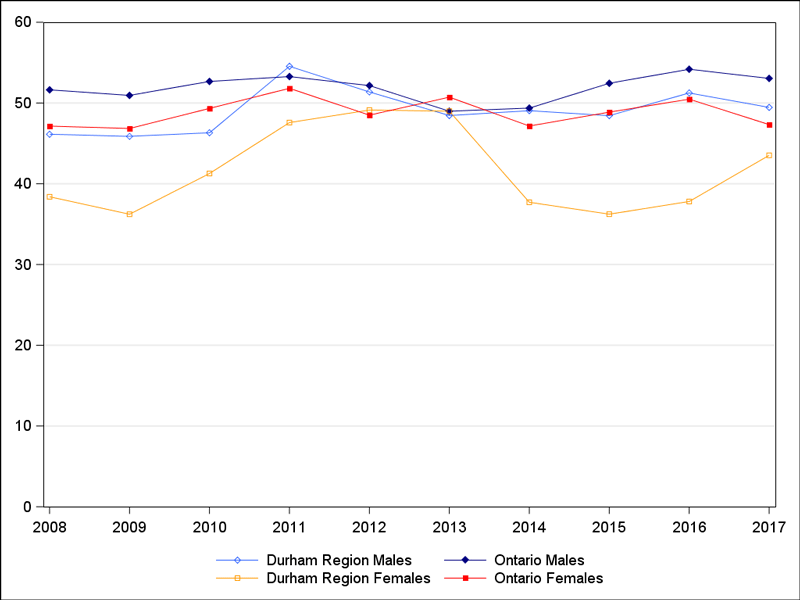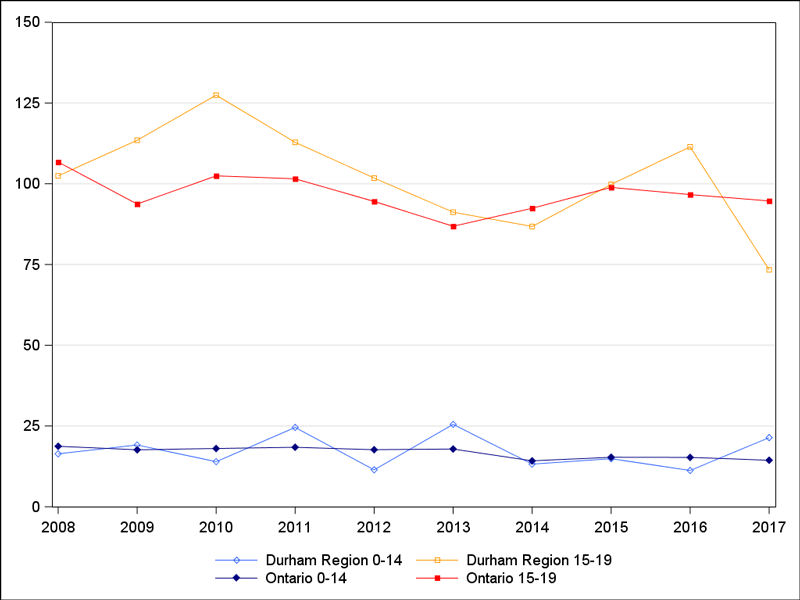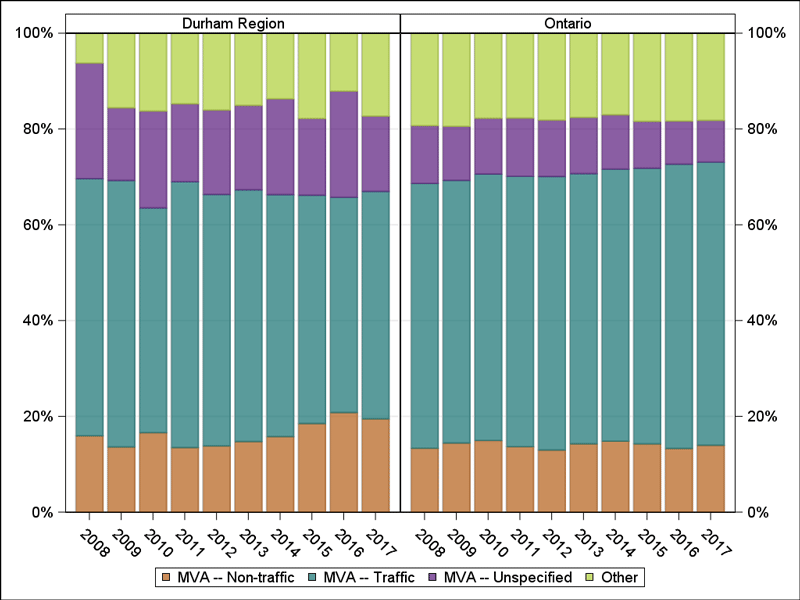
Pedestrian-Related Emergency Department Visits at a Glance
Release date: July 2018
Highlights
- This report demonstrates the burden of pedestrian injuries by examining the rates of pedestrian-related emergency department (ED) visits in Durham Region residents.
- The rates of pedestrian-related ED visits have remained unchanged in the 10-year period between 2008 and 2017. In 2017, there were 318 pedestrian-related ED visits in Durham Region residents. About one-third of the ED visits occurred between September and November (98/318), and between the hours of 6 and 9 pm (93/318).
- The pedestrian-related ED visit rates were consistently lower in females than males, and Durham Region’s rates were lower than the provincial rates.
- The highest rates occur in youth and young adults aged 15 to 19 and 20 to 24 years. The age-specific rates have remained stable over the past 10 years, respectively. Between 2008 and 2017, there were, on average, 44 ED visits in Durham Region youth and 35 ED visits in young adults each year for pedestrian-related injuries
- Most (83%) pedestrian-related ED visits involved collisions with motor vehicles. Almost half (47%) of these were traffic-related injuries that is, pedestrians injured in collisions with motor vehicles on public roads.
Figure 1: Age-standardized pedestrian-related ED visit rates per 100,000 in Durham Region and Ontario, by sex, between 2008 and 2017

| Data table for figure 1 | ||||||||||||||||||||||||||||||||||||||||||||||||||||||||||||||||||||||||||||||||||||||||||||||||||||||||||||||||||||||||
|
||||||||||||||||||||||||||||||||||||||||||||||||||||||||||||||||||||||||||||||||||||||||||||||||||||||||||||||||||||||||
Figure 2: Age-specific pedestrian-related ED visit rates per 100,000 in Durham Region and Ontario individuals aged 0 to 14 and 15 to 19, between 2008 and 2017

| Data table for figure 2 | ||||||||||||||||||||||||||||||||||||||||||||||||||||||||||||||||||||||||||||||||||||||||||||||||||||||||||||||||||||||||
|
||||||||||||||||||||||||||||||||||||||||||||||||||||||||||||||||||||||||||||||||||||||||||||||||||||||||||||||||||||||||
Figure 3: Age-specific pedestrian-related ED visit rates per 100,000 in Durham Region and Ontario individuals aged 20 to 24 and 25 to 44, between 2008 and 2017

| Data table for figure 3 | ||||||||||||||||||||||||||||||||||||||||||||||||||||||||||||||||||||||||||||||||||||||||||||||||||||||||||||||||||||||||
|
||||||||||||||||||||||||||||||||||||||||||||||||||||||||||||||||||||||||||||||||||||||||||||||||||||||||||||||||||||||||
Figure 4: Per cent of pedestrian-related ED visit codes, by nature of injury, in Durham Region and Ontario between 2008 and 2017

| Data table for figure 4 | ||||||||||||||||||||||||||||||||||||||||||||||||||||||||||||||||||||||||||||||||||||||||||||||||||||||||||||||||||||||||||||
|
||||||||||||||||||||||||||||||||||||||||||||||||||||||||||||||||||||||||||||||||||||||||||||||||||||||||||||||||||||||||||||
Data Sources
ED visit data are collected by the Canadian Institute for Health Information (CIHI) on a fiscal year basis. The main diagnostic code is the “main problem” (MP). A second set of codes, external cause codes (e-codes) are used to classify the environmental events, circumstances and conditions that cause an injury (i.e. pedestrian injured in a collision with a car or van). external cause codes are not used as a MP so need to be examined separately. Multiple external cause codes can exist for each visit. The counts shown for groupings of external cause codes (i.e. ICD-10 codes V01-V09) are actually counts of e-codes; not counts of ED visits.
ED visit data provide only a crude measure of the burden of pedestrian injuries. Data are influenced by factors that are unrelated to health status such as availability and accessibility of care, administrative policies and hospital procedures. This may influence comparisons between areas and over time.
For all indicators, data were analyzed by the residence of the patient, not where the ED visit occurred. Ontario residents treated outside of the province were excluded. Data were reported by calendar year, based on the year of the ED visit. This report includes ED visit indicators with relevance to public health programming.
Pedestrian-related ED visits were selected using ICD-10-CA codes V01 – V09. ED visits that resulted in a transfer to another ambulatory care facility were included in the counts. In Figure 4, e-code categories were defined using the following codes: MVA-traffic V03 (.1), MVA-non-traffic V03 (.0), MVA-unspecified V03 (.9) and other.
Definitions
Figures and tables are provided for the following indicators:
- Age-standardized pedestrian-related ED visit rates by sex
- Age-specific pedestrian-related ED visits rates in individuals aged 0 to 14 years, 15 to19 years, 20 to 24 years and 25 to 44 years
Age-standardized ED visit rate
An age-standardized ED visit rate is the number of ED visits per 100,000 that would occur if the population had the same age distribution as the 2011 Canadian population. This rate provides a single summary number that allows populations with different age compositions to be compared.
Age-specific ED visit rate
This rate is the total number of ED visits in a specified age group per 100,000 population in that age group. The numerator and denominator refer to the same age group.
For more information
Contact Us




